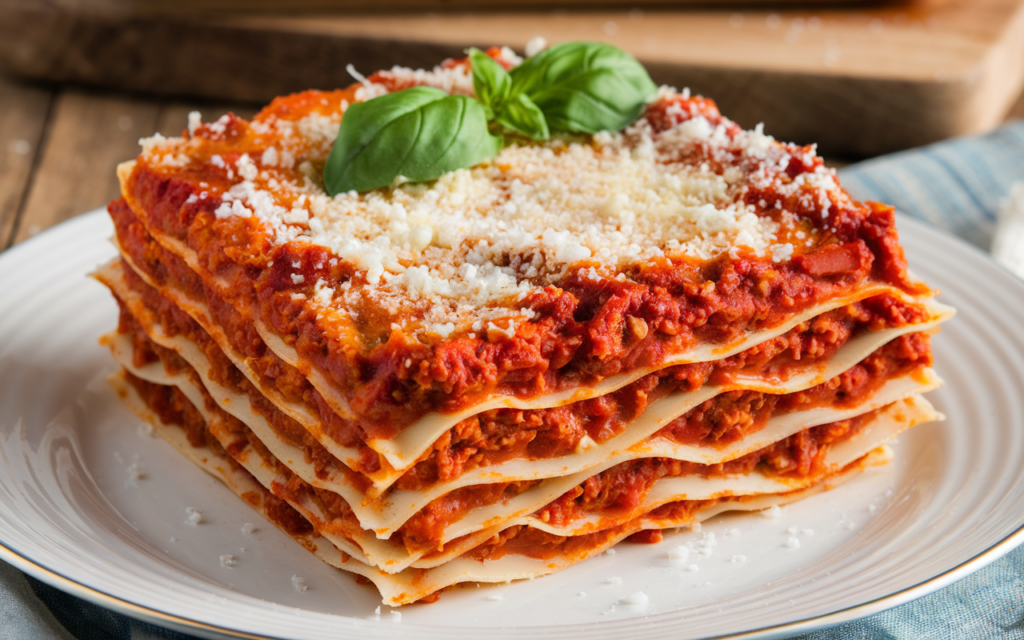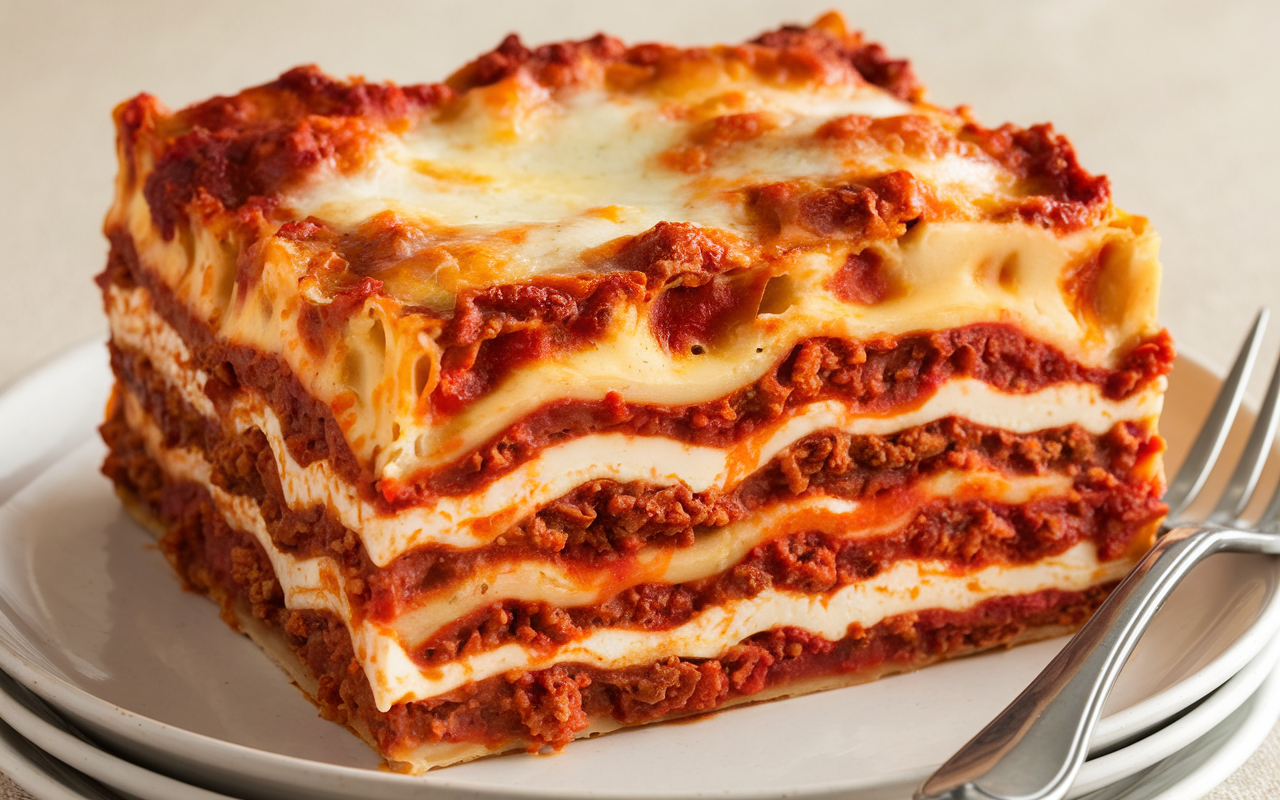Lasagna is a timeless dish, beloved in kitchens all around the world. The savory layers of pasta, cheese, and sauce create the ultimate comfort food, ideal for any occasion. When it comes to preparing a flawless lasagna, Barilla offers a range of premium pasta options, making the task easier while ensuring a rich and satisfying end result. Whether you’re preparing a family feast or a comforting weeknight dinner, the Barilla lasagna recipe below will guide you every step of the way.
Why Barilla Lasagna Noodles Are the Perfect Choice
When it comes to pasta, quality makes all the difference. Barilla, known for its high standards, produces lasagna noodles that stand out in several ways. The semolina and durum wheat they use give the noodles a firm, yet tender texture that holds up well during baking. Unlike other brands, Barilla noodles don’t require pre-boiling, which makes them incredibly convenient. You simply layer them directly into your dish, and they cook perfectly as the lasagna bakes.
Furthermore, Barilla offers options to accommodate different dietary needs, including gluten-free lasagna noodles. These are an excellent choice for those who require gluten-free meals without sacrificing flavor or texture. When you choose Barilla, you’re not just opting for a product—you’re choosing a tradition of quality that ensures your lasagna will turn out great every time.
The Ingredients for a Perfect Barilla Lasagna
To make the best Barilla lasagna recipe, you need high-quality ingredients that will work together to create rich, flavorful layers. Here’s what you’ll need to assemble your lasagna:
the Meat Sauce:
- 1 lb ground beef (or a mixture of beef and pork for a richer flavor)
- 1 onion, finely chopped
- 2 cloves garlic, minced
- 1 can (28 oz) crushed tomatoes
- 1 can (6 oz) tomato paste
- 1/2 cup red wine (optional but recommended for deeper flavor)
- 2 tbsp olive oil
- 1 tsp dried oregano
- 1 tsp dried basil
- Salt and pepper, to taste
the Ricotta Filling:
- 15 oz ricotta cheese
- 2 cups shredded mozzarella cheese
- 1/2 cup grated Parmesan cheese
- 1 egg (to bind the mixture)
- 1/4 cup fresh basil or parsley, chopped
- Salt and pepper, to taste
the Assembly:
- 1 box Barilla lasagna noodles
- 2 cups shredded mozzarella cheese (for the top layer)
- 1/2 cup grated Parmesan cheese (for the top layer)
A Step-by-Step Guide to Making Barilla Lasagna
With your ingredients gathered, it’s time to assemble and bake the Barilla lasagna. Below is a detailed breakdown of each step to ensure your lasagna turns out perfect every time.
Step 1: Preparing the Meat Sauce
To start, heat the olive oil in a large saucepan over medium heat. Add the chopped onion and garlic, cooking until the onion softens and becomes translucent, which should take about 3-4 minutes. Next, add the ground beef (or pork and beef mixture), breaking it up with a spoon as it cooks. Brown the meat for around 5-7 minutes, ensuring it is thoroughly cooked.
Once the meat is browned, stir in the crushed tomatoes and tomato paste, followed by the red wine (if you’re using it). For added depth of flavor, sprinkle in the oregano, basil, salt, and pepper. Let the sauce simmer for 20-30 minutes, stirring occasionally. This will allow the flavors to meld and the sauce to thicken.
Step 2: Making the Ricotta Filling
In a large mixing bowl, combine the ricotta cheese, shredded mozzarella, and grated Parmesan. Add the egg, fresh basil or parsley, and season with salt and pepper. Stir everything together until the ingredients are well combined. The egg will help bind the mixture, while the cheese will provide richness and flavor. This step ensures your lasagna will have a smooth, creamy filling that perfectly complements the meat sauce.
Step 3: Cooking the Barilla Lasagna Noodles
Now, bring a large pot of salted water to a boil. Add the Barilla lasagna noodles and cook according to the package instructions, usually about 8-10 minutes. You want the noodles to be al dente, as they will soften further in the oven. Once cooked, drain the noodles and lay them flat on a sheet of parchment paper to prevent them from sticking together.
Step 4: Assembling the Lasagna
Preheat your oven to 375°F (190°C) while you prepare to assemble your lasagna. Begin by spreading a thin layer of the meat sauce on the bottom of a 9×13-inch baking dish. Then, layer the Barilla lasagna noodles over the sauce. Next, spread a layer of the ricotta cheese mixture over the noodles, followed by a generous layer of meat sauce. Repeat these layers—noodles, ricotta, and meat sauce—until you’ve used up all the ingredients.
For the final layer, place a final layer of noodles on top and cover it with the remaining meat sauce. Then, sprinkle the top with the remaining mozzarella and Parmesan cheese.
Step 5: Baking the Lasagna
Cover the baking dish with aluminum foil to prevent the top from burning. Bake the lasagna for 25 minutes. After 25 minutes, remove the foil and bake for another 25-30 minutes, or until the cheese on top is golden and bubbly. The lasagna should be heated through and the edges slightly crispy. Let the lasagna rest for 10-15 minutes before slicing—this helps the layers set and makes serving easier.
Extra Tips for the Perfect Barilla Lasagna
Although following the steps above will ensure a great lasagna, here are some additional tips that will take your Barilla lasagna recipe to the next level:
- Rest the Lasagna: Allowing your lasagna to rest for 10-15 minutes after baking is essential. Not only does it help the layers set, but it also makes slicing much easier.
- Make-Ahead Option: Lasagna can be prepared a day in advance and stored in the refrigerator. When you’re ready to bake it, simply add a few extra minutes to the baking time.
- Add More Vegetables: If you want to add more vegetables for added flavor and nutrition, consider layering in some sautéed spinach, mushrooms, or even roasted zucchini.
- Avoid Over-Saucing: Adding too much sauce can lead to a soggy lasagna. Use just enough to coat each layer, ensuring the noodles don’t become too wet during baking.

Frequently Asked Questions
Do you need to boil Barilla lasagna?
No, Barilla lasagna noodles do not require pre-boiling. Simply layer them directly into your lasagna, and they will cook perfectly as the dish bakes.
What are the correct layers for lasagna?
The typical lasagna layers are:
- A layer of sauce
- A layer of noodles
- A layer of cheese mixture (ricotta, mozzarella, Parmesan)
- A layer of meat or vegetable filling Repeat these layers and finish with a layer of noodles, sauce, and cheese on top.
How to make homemade lasagna like Gordon Ramsay?
Gordon Ramsay’s lasagna recipe is known for its inclusion of fresh pasta sheets and a rich, flavorful Bolognese sauce. He also adds béchamel sauce for extra creaminess. If you want to experiment with Gordon Ramsay’s version, check out his lasagna recipe for more details.
What are common mistakes when making lasagna?
Here are a few common mistakes to avoid:
- Overcooking the noodles. If you’re using pre-boiled noodles, make sure they are not overcooked, as this can make the lasagna soggy.
- Skipping the resting time. Allow the lasagna to rest for 10-15 minutes to ensure it slices properly.
- Using too much sauce. A good lasagna should have a balanced sauce-to-noodle ratio, so don’t overdo it.
1. The Best Meat for Lasagna
This section can dive into the various types of meats that work best for lasagna. You could cover:
- Ground beef: A classic choice for a hearty, flavorful lasagna.
- Ground turkey: A leaner alternative for those looking to reduce fat.
- Sausage: Adding Italian sausage to your lasagna gives it a richer, spicier flavor.
- Chicken: For a lighter version of lasagna, ground or shredded chicken works well. You could also include tips for seasoning the meat properly to enhance the flavor.
2. Barilla Lasagna: A Comfort Food Classic
Discuss why lasagna, particularly made with Barilla noodles, is considered one of the ultimate comfort foods. This section could highlight:
- The satisfaction of layering rich ingredients.
- How it can be a family favorite that brings people together.
- The nostalgic feel of enjoying homemade lasagna. This is a great emotional appeal, emphasizing the warmth and heartiness of the dish.
3. How to Achieve the Perfect Lasagna Texture
This section can explain how to get that perfect lasagna texture—crispy on top, creamy in the middle, and firm enough to hold together when sliced. Key topics could include:
- The importance of allowing the lasagna to set before slicing.
- How different cheeses affect the texture of the layers.
- The role of the sauce in creating a smooth consistency without being too watery. This will be especially helpful for readers who want to perfect the texture of their lasagna.
4. Cooking Lasagna in the Oven vs. Other Methods
Explain the pros and cons of cooking lasagna in the oven compared to other cooking methods:
- Oven-baked lasagna: The traditional way for the perfect golden top and even cooking.
- Slow cooker lasagna: Ideal for busy days, but it may have a slightly different texture.
- Instant Pot lasagna: Faster cooking time, but readers may want tips on how to avoid soggy noodles. This section can help readers decide which cooking method best fits their needs.
5. The Role of Fresh Ingredients in Lasagna
Highlight how using fresh, high-quality ingredients can elevate the taste of lasagna:
- Fresh pasta vs. dried Barilla noodles.
- Homemade marinara sauce vs. store-bought.
- The difference that fresh herbs (like basil) and freshly grated cheeses can make. This section will appeal to foodies and home cooks who want to make their lasagna even more delicious.
6. How to Make Lasagna in Individual Portions
For readers who prefer single-serving lasagna or want to make lasagna for meal prep, this section could include:
- Using muffin tins or ramekins to create individual lasagnas.
- Adjusting cooking time for smaller portions.
- Ideas for customizing individual portions with different ingredients (e.g., vegetarian for one, meat for another). This could appeal to those who want to serve lasagna at parties, for meal prepping, or for picky eaters.
7. Lasagna Sauce Options
Expand on the variety of sauces that can be used in lasagna, not just traditional marinara. Include:
- Traditional marinara: Tomato-based, rich, and simple.
- Béchamel sauce: A creamy white sauce, often used in lasagna for a velvety texture.
- Pesto: For a fresh, herby twist on lasagna.
- Alfredo: A rich, cheesy sauce for a decadent version of lasagna. This will help readers experiment with different flavors and make their lasagna unique.
8. How to Make a Healthier Barilla Lasagna
For health-conscious readers, you could include a section on making a healthier version of Barilla lasagna:
- Low-fat cheese options: Use part-skim mozzarella or ricotta.
- Whole wheat Barilla noodles: A healthier alternative to traditional pasta.
- Adding vegetables: Incorporate more vegetables like spinach, zucchini, or mushrooms to reduce the calorie count and add nutritional value. This section will cater to readers looking for healthier alternatives without compromising on taste.
9. Why Lasagna Is Great for Leftovers
Lasagna is one of those dishes that often tastes even better the next day. This section can emphasize the benefits of lasagna as a leftover dish:
- Flavor development: The flavors in lasagna deepen after sitting in the fridge overnight.
- Easy to reheat: Lasagna can be reheated quickly in the oven, microwave, or even on the stovetop.
- Meal prep: Why lasagna is perfect for meal prepping for the week. This section would provide added convenience for readers who love leftovers.
10. Barilla Lasagna and Pairing with Sides
Expand on the topic of side dishes, providing detailed ideas for pairing Barilla lasagna with complementary sides:
- Italian-inspired sides: Garlic bread, roasted vegetables, or a Caprese salad.
- Healthy sides: A simple mixed greens salad or steamed broccoli for a lighter meal.
- Comfort food sides: Mashed potatoes or a creamy side dish to balance the richness of lasagna. This section will give readers well-rounded meal ideas and enhance their lasagna experience.
11. Cooking Lasagna for a Crowd: Tips and Tricks
For readers hosting a large gathering or family dinner, this section could provide helpful tips:
- How to adjust the recipe for larger quantities.
- The best ways to keep lasagna warm while serving.
- How to make multiple pans of lasagna ahead of time and store them. This section will make your recipe more versatile for different serving sizes and occasions.
12. Barilla Lasagna Noodles: FAQs
Include a list of frequently asked questions specifically about Barilla lasagna noodles, such as:
- Do Barilla noodles need to be boiled before using?
- How many layers should a traditional lasagna have?
- Can I substitute Barilla noodles with other pasta brands? This will address common doubts and increase your article’s helpfulness.
The History of Lasagna: A Culinary Journey
Lasagna has a long and fascinating history that dates back to ancient times. In fact, historians trace lasagna’s roots to Ancient Greece, where a dish called “Laganon” was created. This early form of lasagna consisted of layers of pasta dough and sauce. However, the lasagna we know today began to take shape in Italy, particularly in the Emilia-Romagna region, where rich layers of pasta, meat, and cheese became the standard.
Over the centuries, the dish evolved, with regional variations incorporating different meats, cheeses, and sauces. Today, lasagna is beloved worldwide, with numerous variations including vegetarian, seafood, and even gluten-free versions. It’s a testament to the dish’s versatility and enduring appeal.
Can I Make Lasagna in Advance?
One of the greatest things about lasagna is that it can be made in advance, saving you time on the day of the event. Whether you’re hosting a large family dinner or simply want to prepare a meal for the week, lasagna is an excellent make-ahead dish. You can prepare the entire lasagna a day or even two before baking.
Steps for Making Lasagna in Advance:
- Assemble the lasagna as instructed, but do not bake it yet.
- Cover it tightly with plastic wrap or aluminum foil and refrigerate for up to 48 hours.
- Bake it as usual, but add 10-15 extra minutes to the cooking time to ensure it’s heated through.
If you want to store it for longer, you can freeze your lasagna instead. Simply cover it with plastic wrap and foil, and store it in the freezer for up to three months. When you’re ready to bake it, simply thaw it in the fridge overnight and bake as directed.
For more tips on meal prep, you can refer to EatingWell’s make-ahead meal ideas.
Healthier Lasagna Alternatives
While traditional lasagna is undeniably delicious, it’s often quite rich. If you’re looking to make a healthier version without compromising on flavor, here are a few simple swaps:
- Lean Ground Meat: Instead of using regular ground beef, opt for lean ground turkey or chicken to reduce fat.
- Vegetarian Lasagna: Swap out the meat entirely for roasted vegetables like zucchini, bell peppers, mushrooms, and spinach. You can also add a plant-based ricotta alternative.
- Whole Wheat or Gluten-Free Lasagna Noodles: Barilla offers both whole wheat and gluten-free noodles for those looking for a healthier or dietary-specific option.
- Low-Fat Cheese: Use low-fat ricotta or mozzarella to cut down on calories while still maintaining the creamy texture.
You can also check out Healthline’s tips on making healthy lasagna.
What to Serve With Lasagna: Perfect Pairings
Lasagna is a hearty, filling dish that can stand on its own. However, there are plenty of sides and beverages that complement it beautifully. Here are a few ideas to elevate your meal:
Sides:
- Garlic Bread: Crunchy and buttery, garlic bread is the perfect accompaniment to lasagna. It’s great for dipping into the sauce.
- Caesar Salad: A crisp Caesar salad with a tangy dressing balances the richness of the lasagna.
- Roasted Vegetables: Roasted vegetables like asparagus, carrots, and broccoli provide a lighter, healthier option.
Beverages:
- Sparkling Water: If you prefer a non-alcoholic beverage, sparkling water with a slice of lemon or lime is refreshing and cleanses the palate.
For more serving suggestions, check out this food pairing guide from Bon Appetit.
The Secret to a Crispy Top Layer
One of the most sought-after features of a perfect lasagna is a golden, crispy top layer of cheese. To achieve this crispy, bubbling finish, here are a few tips:
- Don’t cover it too early: While you want to cover the lasagna during the first part of baking to avoid burning the cheese, uncovering it for the last 10-15 minutes of baking will allow the cheese to brown.
- Use the broiler: If you prefer an even crispier top, you can broil the lasagna for 1-2 minutes at the end of baking. Be sure to keep a close eye on it to avoid burning.
Conclusion
Making lasagna with Barilla noodles is a rewarding experience that brings rich flavors and comforting layers to the table. With easy-to-follow instructions and high-quality ingredients, you can create a lasagna that everyone will love. Whether you opt for a traditional meat-based version or a healthier alternative, this dish is sure to impress. Don’t forget, the key to a perfect lasagna lies in choosing the right ingredients, making it ahead of time when possible, and taking the time to bake it to perfection. With the tips and variations above, you’re now equipped to create the best Barilla lasagna every time!

